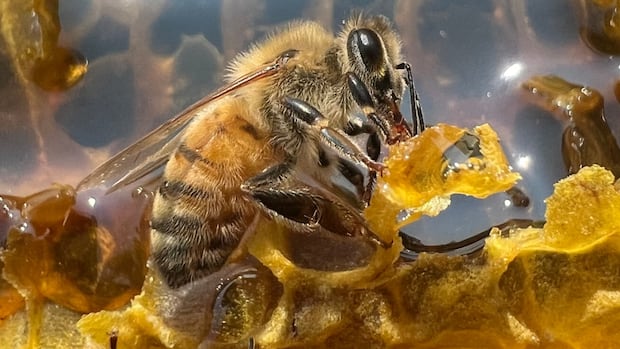B.C. bat experts say the ‘misrepresented’ mammals need ‘condos,’ not rooms

Small wooden tree-mounted boxes for bats are an increasingly common sight in B.C.’s urban parks, often resembling birdhouses except with entrances underneath.
After a string of tragedies near bat boxes, B.C. scientists teamed up to investigate.
What they learned over four years, they say, has changed how we should be building summertime homes for mother bats and their pups, with the species’ survival at stake.
“For them to to raise that young they need just-right temperatures to do so,” explained study co-author Cori Lausen. “And all it takes is about a degree or two to put the temperatures of these bat boxes into a lethal zone.”
Based in Kaslo, B.C., nearly 200 kilometres east of Kelowna in B.C.’s Interior, Lausen is considered a foremost bat expert, known for her Royal B.C. Museum handbook Bats of British Columbia.
Their findings: for bat species that raise offspring in roosts — usually tree hollows or building attics — a single-room occupancy home is not safe without multiple other areas nearby to move to if they overheat.
Even better are multi-unit buildings they nicknamed bat “condos.”
“That gives them more options,” explained another bat researcher, Susan Dulc, at Thompson Rivers University. “For reproductive females that form colonies, bigger and more is better.”
Darius Mahdavi, CBC’s science and climate specialist, takes Amy Bell through a study published in the Biology Journal on the mating habits of Serotine bats. Researchers found the species uses penis in a unique way during reproduction in order to completely avoid penetration.
Red flags for survival
The Wildlife Conservation Society Canada launched its study after a troubling series of incidents near bat boxes, said Lausen, who directs the non-profit’s western bat program.
“The main red flag occurred right around four or five years ago,” Lausen recalled. “We were starting to notice bats dropping dead out of bat boxes and in some cases big piles of dead bats.”
One particularly tragic incident occurred at ƛ̓éxətəm Regional Park in Port Coquitlam, about 25 kilometres east of Vancouver, then called Colony Farm. It was a wake-up call.
“It’s particularly depressing for myself, because I have put my entire adult life into trying to save them,” Lausen said. “We started looking more closely at why that might be going on.”
Their study — “Best Management Practices for the Use of Bat Houses in the US and Canada” — looked into which structures were best designed to help bats survive temperature fluctuations. They recommend roosts with at least four rooms, or multiple boxes with varying degrees of sun exposure.
In particular, researchers focused on summertime shelters used by three at-risk bat species: yuma myotis, big brown bats, and little brown myotis.
The latter species was declared endangered a decade ago by the federal government, which stated it’s at risk of “catastrophic declines” to less than one per cent of its population due to “massive mortality events.”
Both species are also at particular risk for a severe and fatal fungus known as white-nose syndrome, which has killed millions of bats.
“Watching bats die is not what any of us really want to see,” Lausen said.
She said she’s been heartened to see more people going to some effort to help the furry flyers — including landowners manually raising and lowering sun shades during heat waves to cool their bat houses out of concern. Lausen’s new design advice makes that task easier.
“It’s been fabulous watching how many people care about the bats,” she said. “There’s so many roles that bats play by being the main consumer of nighttime insects.”
“We need bats; of course, they need us too.”

‘Love at first bite’
Lausen is part of a small but passionate community of researchers who focus on the flying mammals.
Her obsession with bats started two decades ago, during her biology undergraduate studies, when she encountered her first bat up close.
“It was kind of love at first bite for me — literally — because it was a big brown bat in an attic, and it bit,” she recounted. “I realized this is a wild animal that we know so little about.
“That first bat I held was older than me. I thought, ‘How is that even possible, this tiny little animal?'”
Some species of the nocturnal animals can live for well over 20 or even 30 years, Lausen said, and most only have one or two babies a year.
They are the only mammal that has evolved to fly. But not all bats live in large colonies, nor do they spend all year hanging from cave roofs — a behaviour generally reserved for hibernation, if there are no insects to eat.
“There’s a lot of myths,” Lausen said. “For many years, people have expressed fear of bats … Humans tend to think negative things about things we don’t really understand or we can’t see.
“Bats are underdogs, really, in many ways.”

There are risks to handling or being bitten by bats: they can occasionally transmit rabies, and experts believe bat species in Asia played a role in the origins of human coronaviruses. Researchers get rabies vaccines and wear protective equipment.
But for non-scientists, Lausen said the risks are negligible.
“That’s for us to worry about,” she said. “People shouldn’t be handling bats, but as just a member of the public, you don’t have to worry.”
Bat scientists wear thick gloves, respirator masks, and sometimes protective suits when handling the animals.
“For their protection,” Dulc added, “not ours.”

She remembers her first encounter with the furry flyers, where she instantly wanted to help them survive.
In 2012, Dulc was studying butterflies, when Lausen invited her to help put out bat nets over a lake.
Dulc discovered one tangled in the water and plunged to its rescue without hesitation.
“The water was so deep it filled my waders up,” she recalled. “I didn’t really care, ‘I’ve got to make sure this poor little bat doesn’t drown.’
“I think they’re really, really cute. All of them. They’re misrepresented.”





